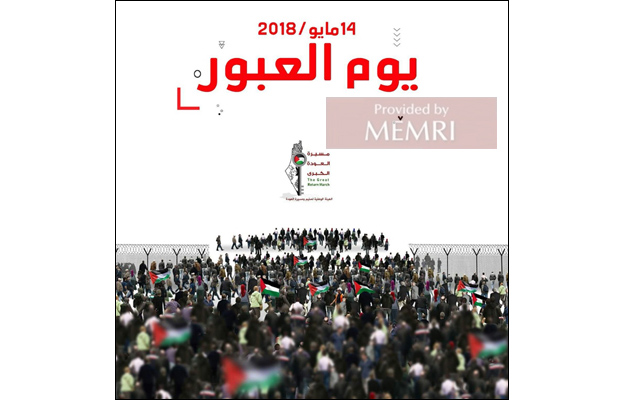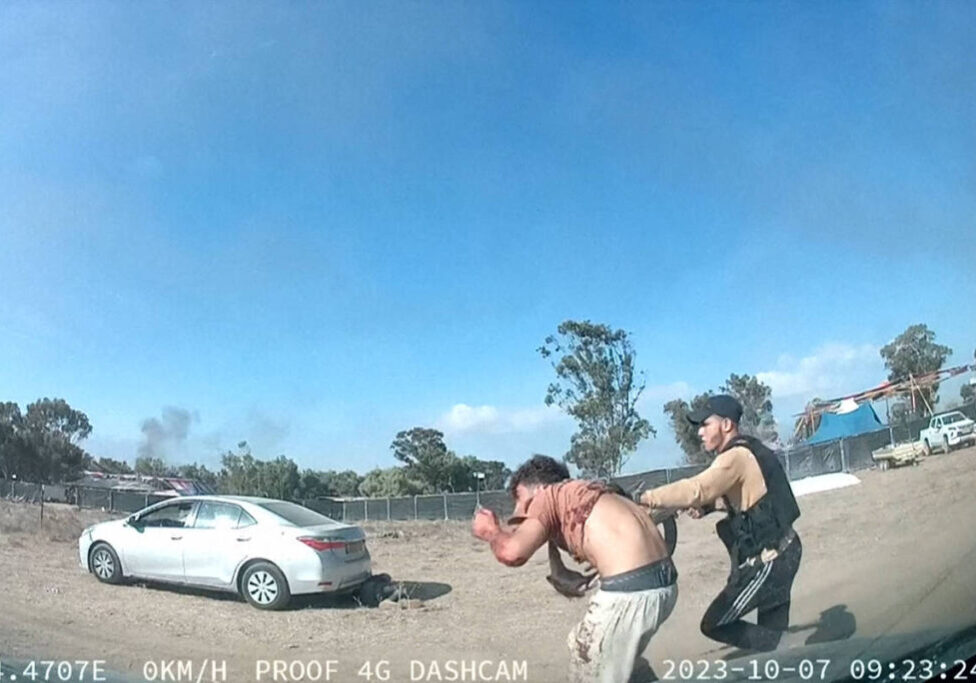Australia/Israel Review
The “Great Return March” Campaign in Hamas’ own words
Jun 5, 2018 | MEMRI

An examination of statements coming out of Gaza about the “Great Return March” campaign, by Hamas officials, by campaign organisers, and by participants and supporters of the campaign, reveal that it was not merely a popular civilian campaign but was fully supported by Hamas, and that its goal was to breach the border fence in order to penetrate Israeli territory and march on Israeli communities. Since it began, on Land Day (March 30), Hamas officials have paid visits to the camps along the border where the marchers congregate, to express their support and encouragement. Hamas officials noted that movement members had participated in the marches and that they comprised the majority of fatalities. Hamas leader Mahmoud Al-Zahar even emphasised that the march was not a form of peaceful resistance.
Organisers of the campaign, such as Ahmad Abu Ratima, one of its prominent spokesmen, noted on more than one occasion that the goal of the march was to breach the border and advance on Israeli communities in the area, even at the cost of Palestinian lives. Throughout the campaign, Gazan social media users posted maps showing the routes and the distances from parts of the Gaza Strip to the Israeli Gaza border communities. Reports mentioned that special units had been established for the purpose of penetrating Israeli territory, such as the Fence-Cutting Unit and the Border-Storming Unit. Although the campaign organisers stressed that the marches would be peaceful, some Gazan social media users called to fight the “infidels” in these communities and to murder them.
This report reviews statements by Gazans regarding the character and goals of the Great Return March campaign:
Hamas officials: 50 of the fatalities were Hamas members; This is not peaceful resistance
Hamas officials have admitted on several occasions that the movement took an active part in the marches. Hamas leader in Gaza, Yahya Sinwar, said that movement members “took off their military uniforms and put their weapons aside. They temporarily abandoned the means of armed struggle” and joined the marches.
Hamas political bureau member Saleh Bardawil said that of the 62 people killed in clashes along the Gaza border on May 14, 50 were movement members.
Hamas official Mahmoud Al-Zahar said that calling the campaign “peaceful resistance” was to “deceive the public”. He said: “When you are in possession of weapons that were able to withstand the occupation in the wars of 2006, 2008, 2012, and 2014… When you have weapons that are being wielded by men who were able to prevent the strongest army in the region from entering the Gaza Strip for 51 days, and were able to capture or kill soldiers of that army – is this really ‘peaceful resistance’? This is not peaceful resistance. Has the option [of armed struggle] diminished? No. On the contrary, it is growing and developing. That’s clear. So when we talk about ‘peaceful resistance,’ we are deceiving the public. This is a peaceful resistance bolstered by a military force and by security agencies, and enjoying tremendous popular support.”
Gazans on social media post maps for marchers breaching the border, showing routes, distances to Israeli communities
The social media pages of the Great Return March and its supporters in Gaza posted maps and aerial photos showing the routes and distances from various parts of the Gaza Strip to the Israeli Gaza Border communities. Some of the posts were accompanied by explicit calls to infiltrate these communities by various routes.
The official Facebook page of the Great Return March campaign posted an aerial photo showing the distance between Gaza and the Israeli Kibbutz Kisuffim, with the text: “From the separation fence to Kisuffim: 38 minutes.”
A Gazan posted such maps, and wrote: “[These maps] have been distributed to youths for breaching the border tomorrow. They show the routes to the settlements in the inner occupied territories [i.e., the 1948 territories].” Another user responded: “I am against all these publications [revealing our plans], because now the enemy will take the necessary precautions.”
Another Gazan, on Twitter, likewise posted maps of the Gaza border communities, and wrote: “To anyone who succeeds in entering our occupied soil: There is a fat fish waiting for us very close by: the settlement of Be’eri, located 4-4.5 kilometres from eastern Gaza (north of the Al-Bureij [refugee] camp). It is considered to be one of the richest settlements, and houses some 900 settlers. It can be reached by motorcycle within three or four minutes, and at a quick run in 15-20 minutes.” In another tweet he wrote: “To all the resisting youths who know no fear: All the settlements are close by. If the fence is breached, put your faith in Allah and do not be afraid…”
Muhammad Al-Bursh of Gaza tweeted: “People and residents of Gaza! With Allah’s help, afternoon prayers will be held in the Gaza border settlements of Nativ Ha-Asara, Erez, Sderot, Nir Am [and] Mefalsim. We will meet in the Return Camp north of Jebalia, and set out from there.” The tweet was accompanied by an aerial photo of the communities.
In another tweet the same day, Al-Bursh wrote, paraphrasing directives which, according to Muslim tradition, were conveyed by the Prophet Muhammad and by the Caliph Abu Bakr to their troops before setting out to battle: “During your sacred advance tomorrow, I direct you not to kill children, women or very elderly people. Do not burn date trees or uproot fruit trees.”
Calls on social media for clashes with Israelis after penetrating their communities
Some posts, posters and leaflets published on social media called for clashes with Israelis after breaching the fence and entering their communities. ‘Emad ‘Aql, of Gaza, tweeted: “[The Israeli town of] Sderot is only 700 metres east of [the Palestinian town of] Beit Hanoun in northern Gaza. The headquarters of the Israeli army is there, and houses about 800 pigs. [The town] can be reached in two minutes on motorcycles or in five-eight minutes at a brisk run.” He urged: “Murder, slaughter, burn and never show them any mercy.”
A Gazan Facebook user posted an image of a masked fighter brandishing a knife, with the text: “Kibbutz Kerem Shalom, east of Rafah, is only 300 metres from the border. It has turkey pens, a football field and a pool, [although] it houses only 15 families. Pounce on them with knives.”
The “Palestine Unites Us” Facebook page posted a leaflet in Arabic and Hebrew by “the Palestinian resistance in Gaza.” Addressing the Israeli residents of the Gaza border communities, it tells them to evacuate their homes, saying: “Your only way to survive is to go back to your country of origin, for we are returning”; “Oh Jew, you do not belong here… [you have] no state here, only fear and terror.”
A poster announcing the “March of Millions for Return and for Breaking the Siege,” posted on Twitter, said: “To the rebels advancing on the soil of the homeland… we remind you of your Prophet’s directives: set forth and fight for the sake of Allah against the infidels who [renounce] Allah, [but] do not commit treachery or excess, mutilate bodies or kill children or monks… [the text is taken from a hadith of the Prophet Muhammad].”
The “Border-Storming” and “Fence-Cutting” units
Posts and videos on social media claimed that special units had been established to breach the border fence, including the Border-Storming Unit and the Fence-Cutting Unit. A Facebook page dedicated to the former unit features reports and videos about its activity. One post said, “Youths have cut some of the barbed wire east of Al-Bureij in central Gaza,” and was accompanied by photos documenting this. Another post said: “The Fence-Cutting Unit announces that it is fully prepared to cut the barbed wire and remove it from the entire length of the Gaza border.”
The page also featured a poster captioned “Cut [the Fence], Remove It and Break Forth!”
Footage of the Fence-Cutting Unit was even aired on television. In footage aired April 27 on Hamas’s Al-Aqsa TV, masked members of the unit stood brandishing wire cutters and chanting: “Khaybar, Khaybar, oh Jews, the army of Muhammad has begun to return.”
One of the members proclaimed:
“Oh sons of our rebellious Palestinian people! Oh men who are steadfast on the land of Palestine, from the [Jordan] River to the [Mediterranean] Sea! Today is the day of the march toward our occupied and robbed Palestinian lands. Today, we cut the Zionist enemy’s main barbed-wire fence on the Gaza border, east of the Jebalia refugee camp. Allah willing, today we shall enter our occupied lands, and ignite a revolution against the Zionist enemy, in order to proclaim, loud and clear, that this enemy is destined for perdition, and that what was taken by force will be regained by force alone. We are about to liberate our blessed Palestinian land, which was plundered from us by the enemy by force, and from which the enemy will be driven out by force alone. We have called this Friday ‘The Friday of the Rebel Youth.’ We are the Fence Cutters’ Unit… We are walking on the path of Allah. We want to raise the banner. May Islam regain its glory. May the Al-Aqsa Mosque regain its purity. Let our blood be shed. We, the rebel youth of the Gaza Strip, east of the Jebalia refugee camp, convey a message to the settlers along the border of the Gaza Strip: Leave immediately, before it is too late! The Palestinian revolution will not cease until victory or martyrdom!”
© Middle East Media Research Institute (MEMRI, www.memri.org), reprinted by permission, all rights reserved.
Tags: Hamas






